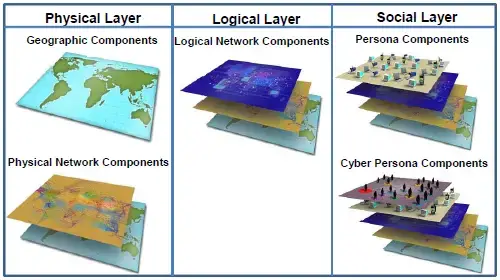
“Cyberspace is becoming increasingly fragmented by autocracies to solidify their own political positions to the detriment of their populations.“
Introduction
In this modern era full of advanced technologies vying for their attention, it has become impossible for most people to imagine their lives without the Internet. There are over 8 billion people on Earth, but not everyone uses the same social media, search engines, or online platforms. One significant reason for this is the role politics plays in shaping our daily lives. Political systems can be categorized into two main types – autocracy, a system of government by one person with absolute power and democracy, a system of government by the whole population or all the eligible members of a state, typically through elected representatives. A majority of countries across the world follow a democratic system of governance and primarily use online platforms developed by Western countries. On the other hand, countries under an autocratic system often have proprietary search engines, social media, and technologies that can be accessed online. As a result, the “Splinternet” has emerged, dividing cyberspace and creating barriers to information and communication.
What is the Splinternet?

To answer this question, it is necessary to understand the term cyberspace. Cyberspace, the electronic realm used for online communication, refers to the virtual computer world. According to “Cyberspace” (2010), cyberspace is comprised of three layers and consists of five components (see figure 1). The first layer is the physical layer, it includes the geographic component which refers to the physical location of the network’s elements and the physical network component which comprises the hardware and infrastructure. The second layer is the logical layer which includes the logical network component and is the logical connection that exists between networks such as protocols and languages. Lastly, the social layer, including the persona component is made up of people who are actually on the network and the cyber persona component refers to a person’s identity or presence on the network. Unfortunately, cyberspace was originally intended for information sharing and exchange, but it has become one of the main targets of military attacks.
The term “Splinternet” refers to the concept of dividing the global internet into multiple fragmented parts usually due to the influence of geopolitical factors, as different countries have varying regulations and laws regarding online activity. This results in the creation of separate and independent networks, which will separate the information that people can access online. Asma Mhalla (2023) noted, “The Splinternet is the establishment of a multipolar Internet, fragmented into as many closed cyberspaces as there are competing blocks in the world.” This can lead to negative implications for various aspects of the shared digital world. Firstly, the Splinternet hinders the free flow of information and ideas across borders. Censorship and content filtering make it easier for governments to limit access to diverse perspectives, stifling freedom of expression. Secondly, it can stop global collaboration and innovation. A unified internet has enabled global cooperation in humanitarian and scientific efforts through the rapid exchange of knowledge. The Splinternet’s fragmentation makes it harder to tackle global challenges such as the recent COVID-19 pandemic. Moreover, the Splinternet raises concerns about privacy and security. Data may be subject to varying rules in different regions, potentially exposing users’ data to malign actors in their country. Hoffmann et al. (2020) have stated, “A fragmented network would introduce new challenges to cyber defence and could provide adversaries with a technical means to undermine the norms, predictability and security of today’s cyberspace” (p.1). In short summary, the fragmentation of the internet driven by geopolitics threatens information flow, global cooperation, innovation, cybersecurity, privacy, and human rights, amplifying the digital divide.
Countries using the Splinternet.
- How China created their own internet.
Since the formation of the PRC in 1949 their government has always placed an importance on the flow of information. Scott Malcomson pointed out in 2016 that three decades ago, citizens of Western countries were able to keep up with developments in China by subscribing to the China Daily. “Chinese or Soviet citizens have had even less information than that about the distant Westerners they were taught to fear”, said Malcomson (2016, p.197). The Great Firewall of China is well-known around the world for how it prevents users from accessing selected foreign websites that it deems to be dangerous or subversive. It is used to filter the content the Chinese population are exposed to and censor any information that is deemed to be incompatible with China’s system of governance. In China, they have their own version of search engines such as Baidu, social media such as WeChat and online platforms such as Taobao. These platforms are heavily regulated and it is noticeable when an incident occurs that is embarrassing for the Chinese Communist Party, it will not be found on these sites. This can be dangerous for the wider population as the content and news posted on their internet must be approved by the government. In this situation, it becomes significantly easier to manipulate the truth and spread misinformation that is helpful to the ruling regime.
- Russia: A Splinternet accelerated by the War in Ukraine.

As previously discussed, cyberspace has become a significant target for military attacks. The conflict in Ukraine serves as a modern example of such an attack, where Russia has focused on destroying Ukraine’s infrastructure, gaining control of their networks, and manipulating the information that people could access on their mobile devices, thereby controlling all three layers of cyberspace. Since the war in Ukraine began, Russia has been stepping up its efforts to create its own splinternet and blocking sites such as X and Facebook that provide points of view sympathetic to Ukraine and information that may be embarrassing to the government. This has become an extremely high priority to Russia as their war with Ukraine hasn’t progressed as quickly as they had previously hoped.
How can users bypass the Splinternet?
Take the Chinese people as an example, they use a variety of methods to bypass the Great Firewall. For those who desire unrestricted access to the global internet, these tactics have become indispensable. Virtual Private Networks (VPNs) are one of the most common tools that are used to get round the firewall. VPNs encrypt internet traffic, routing it through servers located outside of the user’s country, effectively hiding a user’s IP location and giving access to blocked websites. Another option is to use proxy servers, these servers act as intermediaries allowing users to access blocked websites indirectly. Despite all these methods, the Chinese government is constantly modifying its techniques for censoring information and surveillance. It can be dangerous to use non-approved methods to bypass governmental control of the internet. While some users successfully access the unrestricted internet, if they are discovered to be using these illegal methods in China, the government has been known to issue fines or even warrants for jail terms.
Conclusion
To sum up, geopolitical tensions and national interests have resulted in the creation of digital borders and barriers, leading to a fragmented internet landscape that causes significant challenges to the ideals of a global, open, and accessible internet. The political interests of autocratic regimes are causing a fragmentation of cyberspace, which raises pressing concerns. Cyberspace has become fragmented even further in recent years due to events such as the war in Ukraine, many countries becoming part of China’s sphere of influence and following their example in how to police the internet. One of the reasons for this is the fact that the leaders and systems governing these countries are still in place even after a significant number of years. There have been a number of stories reported in the Western media about corruption at the top of these governments, often billions of dollars going missing to the detriment of the countries’ taxpayers, however, this is not reported on in the Splinternet as it is embarrassing for the governing parties.
Reference
Bloomberg Originals. (February 20, 2019). How China Created Its Own Internet . YouTube. https://youtu.be/qBksg5JPLz0?si=xTmxOg3XJzXWaodU
Cyberspace Operations Concept Capability Plan 2016-2028. (2010). The United States Army.
https://irp.fas.org/doddir/army/pam525-7-8.pdf
Hoffmann, S., Lazanski, D. & Taylor, E. (2020). Standardising the splinternet: how China’s technical standards could fragment the internet, Journal of Cyber Policy, 5:2, 239-264, DOI:
https://doi.org/10.1080/23738871.2020.1805482
Malcomson, S. (2016). Splinternet: How Geopolitics and Commerce are Fragmenting the World Wide Web. OR Books.
https://doi.org/10.2307/j.ctt20bbwp4
Mhalla, A. (2023). Splinternet: how geopolitics is fracturing cyberspace. Polytechnique insights.
Rouse, M. (2023). Cyberspace. Techopedia.

